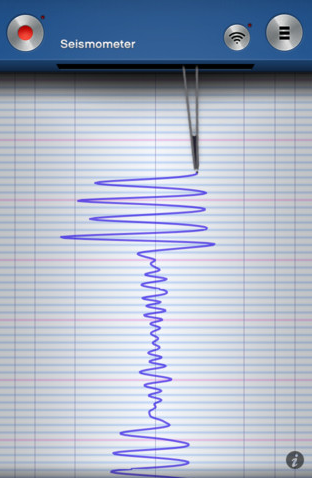We're open daily! View holiday hours
Science News
Smartphone or Seismometer?
December 19, 2012
by Zuberoa Marcos

Researchers at the Berkeley Seismological Laboratory want to use our smartphones, and the sensors they carry, as pocket-sized seismometers to detect and investigate earthquakes. The phones could serve as warning systems that would make the difference between life or death—giving people precious seconds to take cover, alerting trains to slow down, allowing planes to abort landings, or helping surgeons to manage their procedures.
Smartphones contain accelerometers that can detect and record movement, possibly monitoring tremors. UC Berkeley researcher Qingkai Kong told BBC News, “Right now, we can only detect earthquakes above about Magnitude 5.0, but with better accelerometers in future smartphones, we would hope to detect smaller ones as well.”
To see if mobile phones could be used as pocket seismometers, a number of the devices were put on the Seismic Lab's shake table, an instrument that can simulate tremors of various strengths. It is usually employed to test the robustness of various construction techniques to provide confidence that buildings will not collapse during an earthquake. (Science in Action produced a video about this shake table technology earlier this year.)
The researchers found the phone accelerometers, primarily used to re-orient the screen display when the phones are tilted, could pick up the shaking. Since smartphones aren't generally sitting “still” but are moving with their owners, scientists developed an algorithm that removes this movement "noise" from the phones' data.
At present, the researchers are developing an app that will record shaking during major events and then report the data back to a central server over the cellular network.
The Berkeley team hopes to test the app next year with thousands of volunteers across the Bay Area.
Zuberoa Marcos is a former biologist and current science writer based in Barcelona. She writes articles regularly for Science Today.
¿Smartphones o sismómetros?
Por Zuberoa Marcos
Nuestros teléfonos inteligentes van a ser más inteligentes todavía.
Investigadores del Laboratorio Sismológico de Berkeley quieren utilizarlos, en concreto los sensores que llevan, como sismógrafos de bolsillo para detectar e investigar los terremotos. Los teléfonos utilizados como sistemas de alerta podrían marcar la diferencia entre la vida o la muerte dando a las personas uso segundos de adelanto muy valiosos para ponerse a cubierto, para que los trenes frenes, los aviones cancelen aterrizajes y los cirujanos acaben la intervención antes de que llegue el terremoto.
El elemento clave de los smartphones para que puedan hacer este trabajo son sus acelerómetros, capaces de detectar y registrar el movimiento y controlar los temblores. "En este momento, sólo podemos detectar seísmos por encima de magnitud 5,0, pero conforme los acelerómetros se perfeccionen podremos detectar también los de menor intensidad ", dijo a BBC News el investigador Qingkai Kong.
Para comprobar que los teléfonos móviles realmente pueden ser utilizados como sismómetros de bolsillo, los científicos colocaron un buen número de estos dispositivos en la “mesa de sacudidas” del laboratorio, un instrumento capaz de simular temblores de varias intensidades. Se utiliza habitualmente para probar la solidez de distintas técnicas de construcción, para asegurarse de que un edificio no se desplomará durante un terremoto.
Los investigadores comprobaron que los acelerómetros del teléfono, utilizados principalmente para re-orientar la pantalla cuando el teléfono se inclina, podían recoger el temblor. Como los smartphones habitualmente no están sobre una mesa plana sino en movimiento en el bolsillo de sus dueños, los científicos desarrollaron un algoritmo que elimina “ruido” del movimiento de los datos del teléfono.
En la actualidad están desarrollando una app que graba el temblor y luego envía los datos a un servidor central a través de la red de telefonía móvil.
El equipo de Berkeley espera poder realizar los primeros ensayos de la aplicación el próximo año con miles de voluntarios reclutados en San Francisco y la zona de la Bahía.
Zuberoa Marcos es bióloga molecular y actualmente trabaja como productora de TV y periodista científica. Escribe de forma regular para Science Today.
Image: Apple